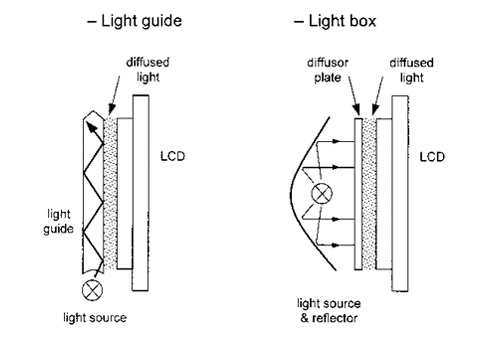In liquid crystal display technology, the liquid crystal screen itself is like a silent stage that cannot emit light to display brilliant images. The LED backlight source behind it is the key to lighting up this stage. It gives life to the liquid crystal display screen, enabling it to display images and text normally. Today, we will uncover the mysteries of the LED backlight source and delve deeper into its working principle and the core components of the backlight module.
A backlight source, by definition, is an object that provides light. In liquid crystal display devices, since LCDs do not emit light themselves, they require a backlight source to illuminate pixels so that the content on the screen can be displayed. Without a backlight source, the liquid crystal display module would only present a pitch-black screen, and no matter how the internal liquid crystal molecules rotate, nothing would be visible from the outside.
Backlight sources can be classified into two types according to their light emission: edge-lit and direct-lit.
- Edge-lit backlight: Low cost, thin, low power consumption, but relatively lower brightness and poor uniformity. It is mainly used in slim electronic products such as mobile phones and notebook screens to reduce product thickness. The light source of the edge-lit backlight module is located on one side of the module, and the light is uniformly distributed on the liquid crystal glass through the conduction of the light guide plate and the refraction of optical film materials.
- Direct-lit backlight: High brightness, good uniformity, and supports local dimming design to enhance brightness and contrast and alleviate light leakage. Therefore, direct-lit backlights are often used in high-end IPS displays. Its light source is located at the bottom of the module, and the light is evenly illuminated on the liquid crystal glass through the diffusion of the diffuser plate and the refraction of optical film materials.

The working principle of the backlight source is to convert point light sources into surface light sources, providing external light sources required for LCD products to display. The combination design of various layers of film materials inside the backlight source is precisely to accomplish this conversion task. Through the coordinated action of elements such as the light guide plate, reflective film, diffuser film, and brightness enhancement film, the point light source emitted by the LED light bar is uniformly distributed across the entire liquid crystal screen.
- Backlight Source: Composed of light-emitting diodes (LEDs) and FPC, it is the light source part of the backlight source. Differences in the color of different LED chips can lead to variations in the color coordinates of the light emitted by the backlight source; therefore, a color coordinate range must be set during product design to constrain product variation.
- Light Guide Plate (LGP): Its main function is to guide the side-entering light into planar light emission. It is a transparent plate with dots on one side, which scatters the light emitted by the LED light bar through the dots to convert it into a surface light source.
- Reflective Film: Located beneath the LGP, it has a very high light reflection efficiency. It reflects the light leaking out from the bottom of the LGP back into the LGP for reuse, increasing the light utilization rate and brightness.

- Diffusion Film: It refracts and scatters the passing light through internal acrylic balls, rough surfaces, or diffusion particles, ultimately uniformizing the light. It effectively homogenizes the light, conceals defects, and ensures that the light is evenly distributed across the entire surface of the liquid crystal screen.
- Brightness Enhancement Film: It has a prism structure on its surface, which focuses the light. It concentrates the scattered light within a certain range, increasing the brightness within that range. When assembled in front of the backlight source, it gathers the light emitted by the backlight source towards the user direction of the display screen, enhancing the front brightness.
The LED backlight source, as one of the core components of liquid crystal displays, its working principle and the composition of the backlight module are important parts of modern optical technology. Through this introduction, I believe you have gained a deeper understanding of the LED backlight source. In the future, with the breakthroughs in Mini LED and Micro LED technologies, LED backlight source technology will become more mature, bringing people even better visual experiences.
The 8 inch displays might be affected and delay for an accident.
New iPhone 13 Series will use On-Cell OLED Displays. And it that will be launched in the second half of this year will be exclusively supplied by Samsung Display (SDC)
This is the project management of how sinocrystal handle your customized project relate to displays.
Discover the key factors to consider when choosing an LCD display for your project, including size, resolution, interface, brightness, and customization options from a factory-direct manufacturer.
Discover the latest innovations in rugged LCD displays for harsh environments — from extreme temperature resistance to sunlight readability and waterproof designs. Factory-direct manufacturing with full customization.
A complete guide to LCD display connection methods, including SPI, I2C, RGB, MIPI, LVDS interfaces and physical mounting options. Learn how to connect monochrome and TFT LCDs to your development board or product housing.
This week, we had the pleasure of hosting an esteemed international client at our LCD display manufacturing facility in Dongguan. Guided by our team, the client visited key production areas such as the fully automated COG bonding line, backlight assembly area, full lamination workshop, and final product aging test section. They highly appreciated our production capacity, strict quality control, and engineering expertise. This visit strengthened mutual trust and set the stage for future collabora